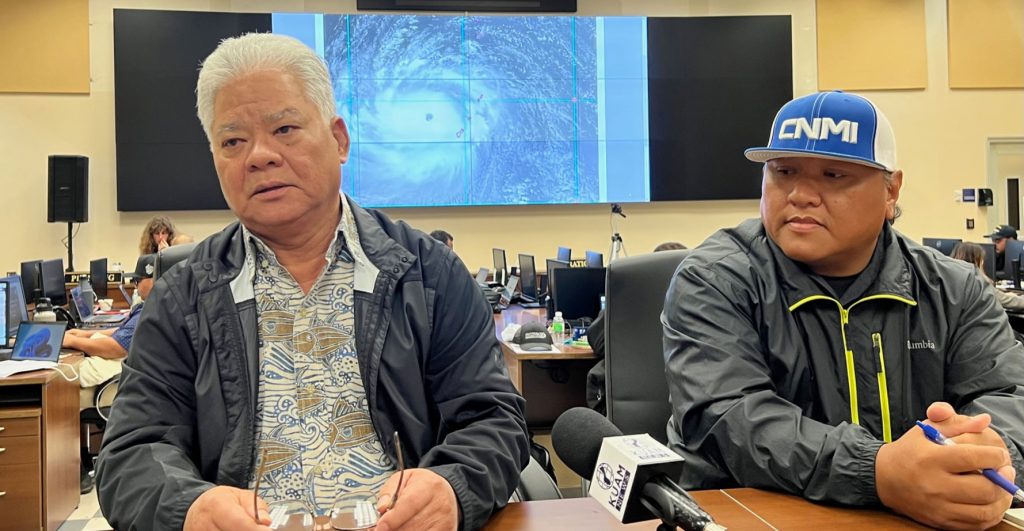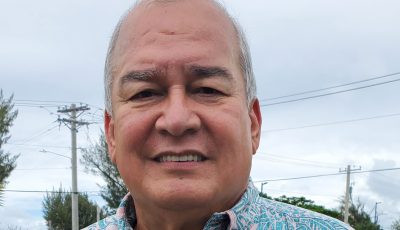‘All clear’ declared for entire NMI

Gov. Arnold I. Palacios, left, accompanied by CNMI Homeland Security Emergency Management agency’s Joey Dela Cruz hold a press briefing to announce the cancellation of tropical storm conditions for Saipan and Tinian. (KIMBERLY B. ESMORES)
Several hours after Typhoon Mawar barreled through the Rota channel on its way outside the Marianas region, Gov. Arnold I. Palacios finally gave the “all clear” signal yesterday for all three islands of Saipan, Tinian, and Rota.
After an initial assessment of the typhoon damage and with guidance from the National Weather Service in Guam, Palacios called off all tropical storm and typhoon conditions for Saipan, Tinian, and Rota and declared an “all clear” for all three islands, paving the way for recovery efforts to begin, especially with bringing needed equipment to Rota, which was most affected by the storm.
After a briefing yesterday by the National Weather Service at the CNMI Homeland Security and Emergency Management headquarters on Capital Hill, Palacios cancelled all conditions for Saipan, Tinian and Rota as of 5:30pm press time.
At around 5:30pm yesterday evening, only Saipan and Tinian had received an “all clear” declaration. Later, at around 8:20pm, Palacios officially issued an “all clear” for Rota.
Palacios disclosed in a separate press briefing yesterday that both Saipan and Tinian sustained no damage, aside from debris but those that have been reported were minor and have been cleared.
On Tinian, Palacios said the administration received a report that a power line was downed by the storm but it has since been fixed by the Commonwealth Utilities Corp. on island.
As for Rota, Palacios said because they bore the brunt of the storm among all three islands, they continue to do assessments and are expected to provide a report today. The consolidated report will provide the administration with a clear picture of what is needed to aid in Rota’s recovery post-Typhoon Mawar.
“A consolidated team made up of government personnel will carefully go out and make sure that the roads are clear and to look at what aid is necessary as a result of Mawar,” he said.
Palacios said that power remains down on Rota and will remain down until equipment and manpower needed can be transported from Saipan to Rota.
“Photos provided to us showed a power pole had fallen across a road on Rota and those have to be cleared and addressed. Power remains down on Rota, but the power plant is OK. There was moisture in one of the engines, so they had to shut it down that’s why power is still out. There are a lot of lines down and the distribution system needs to be fixed,” he said.
“Pending availability of transport, we’re working with the [Federal Emergency Management Agency] and the U.S. Department of Defense to transport equipment down to Rota for CUC, as well as generators for major infrastructures like the hospital. We’re just waiting for clearance,” he added.
Right now, Palacios said, it’s just a matter of when the Department of Defense can deem Rota’s ports safe for entry. Most of the equipment needed for Rota’s recovery has already been pre-staged during the preparation phase.
“One of the key components in this is the airports. DOD needs to do a professional assessment of the runways to determine whether it can land one of their helicopters on Rota. They’re going to be doing that assessment today so we can begin recovery for Rota,” he said.
Overall, Palacios said the CNMI is fortunate because, although Typhoon Mawar wreaked havoc on Rota, there were no fatalities reported.
In addition, on the bright side, Palacios said his administration has learned from this storm and is looking at having more emergency equipment stationed on Rota in case of another disaster, given how isolated the island is and how tricky the Rota channel can be.
“We’re very fortunate that there has been no fatalities. Obviously we’re going to learn a lot from the Rota case, so we can be able to address those in the future. We know now that we need to station a lot of equipment on Rota in case of another storm because it is very isolated and the biggest challenge we’ve faced is how to transport the equipment needed for a storm to Rota,” he said.



























